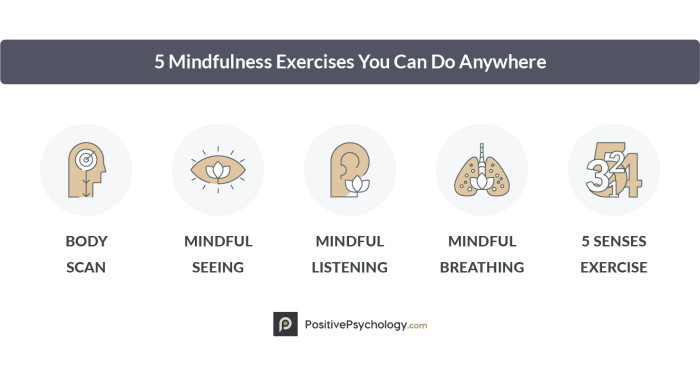Mindfulness Exercises are not just a trend; they are a powerful tool for boosting mental health and improving concentration. Dive into the world of mindfulness with us as we explore the benefits, types, and tips to incorporate these exercises into your daily routine.
Benefits of Mindfulness Exercises
Practicing mindfulness exercises can have a profound impact on mental health and overall well-being. These exercises are known to improve focus, concentration, reduce stress and anxiety levels, as well as enhance emotional regulation.
Mental Health Benefits
- Enhances self-awareness and self-acceptance
- Reduces symptoms of depression and anxiety
- Boosts overall psychological well-being
Improved Focus and Concentration
- Helps train the brain to focus on the present moment
- Enhances cognitive flexibility and problem-solving skills
- Increases attention span and productivity
Reduced Stress and Anxiety Levels
- Encourages relaxation and calms the mind
- Reduces the production of stress hormones
- Enhances resilience to stressors
Impact on Emotional Regulation
- Helps manage and regulate emotions effectively
- Reduces emotional reactivity and impulsivity
- Promotes a sense of emotional balance and stability
Types of Mindfulness Exercises

Mindfulness exercises come in various forms and can be practiced in different settings. These exercises help individuals cultivate present-moment awareness and promote overall well-being.
Mindful Breathing
One common mindfulness exercise is mindful breathing, where individuals focus on their breath as it goes in and out. This practice helps bring attention to the present moment and promotes relaxation.
Body Scan
Another type of mindfulness exercise is the body scan, which involves systematically bringing awareness to different parts of the body. This practice helps individuals connect with their physical sensations and release tension.
Loving-Kindness Meditation
Loving-kindness meditation is a mindfulness exercise that involves sending well-wishes and compassion to oneself and others. This practice fosters feelings of love, kindness, and connection with oneself and the world around.
Anywhere, Anytime Mindfulness Exercises
Examples of mindfulness exercises that can be done anywhere, anytime include mindful breathing during a short break at work, practicing a quick body scan before bed, and sending loving-kindness to someone in need during a commute.
Comparison of MBSR and MBCT
Mindfulness-Based Stress Reduction (MBSR) focuses on developing mindfulness skills to cope with stress, pain, and illness, while Mindfulness-Based Cognitive Therapy (MBCT) integrates mindfulness practices with cognitive therapy techniques to prevent relapse into depression.
Integration into Daily Routines, Mindfulness Exercises
Mindfulness exercises can be integrated into daily routines by incorporating them into activities like brushing teeth mindfully, taking mindful walks in nature, or practicing gratitude before meals. These small moments of mindfulness can have a significant impact on overall well-being.
Mindfulness Exercises for Beginners
Starting out with mindfulness exercises can be a great way to improve your mental well-being. Here are some steps for beginners to kickstart their mindfulness practice:
Creating a Conducive Environment
To create a conducive environment for mindfulness practice, find a quiet and comfortable space where you won’t be easily distracted. You can also add elements like soft lighting, calming music, or essential oils to enhance the atmosphere.
Overcoming Common Challenges
Beginners often face challenges like wandering thoughts or difficulty focusing. To overcome these challenges, try to gently bring your attention back to the present moment whenever your mind starts to wander. Remember, it’s normal to have these distractions, so be patient with yourself.
Staying Consistent
Consistency is key when it comes to mindfulness exercises. Set aside a specific time each day for your practice, whether it’s in the morning, during lunch, or before bed. You can also use reminders or alarms to help you stay on track with your mindfulness routine.
Mindfulness Exercises for Specific Goals
Mindfulness exercises can be customized to target specific goals and outcomes, such as improving sleep quality, managing chronic pain, enhancing self-awareness, personal growth, and improving relationships and communication.
Improving Sleep Quality
Quality sleep is essential for overall well-being. Mindfulness exercises can help calm the mind and relax the body, promoting better sleep quality. Techniques such as deep breathing, body scan meditation, and progressive muscle relaxation can be beneficial in preparing the mind and body for restful sleep.
Managing Chronic Pain
Chronic pain can be debilitating, affecting daily life. Mindfulness exercises like mindful breathing, body scan meditation, and gentle yoga can help individuals cope with pain by increasing awareness and acceptance of sensations without judgment. These techniques can reduce the perception of pain and improve overall quality of life.
Enhancing Self-Awareness and Personal Growth
Self-awareness is key to personal growth and development. Mindfulness exercises such as self-reflection, journaling, and loving-kindness meditation can deepen self-awareness, enhance emotional intelligence, and promote personal growth. These practices can help individuals better understand themselves, their thoughts, and emotions, leading to positive changes and personal transformation.
Improving Relationships and Communication
Effective communication and healthy relationships are vital for emotional well-being. Mindfulness exercises like mindful listening, compassionate communication, and relationship mindfulness can improve communication skills, foster empathy, and strengthen connections with others. These practices can enhance relationship dynamics, resolve conflicts, and promote deeper understanding and connection with loved ones.






